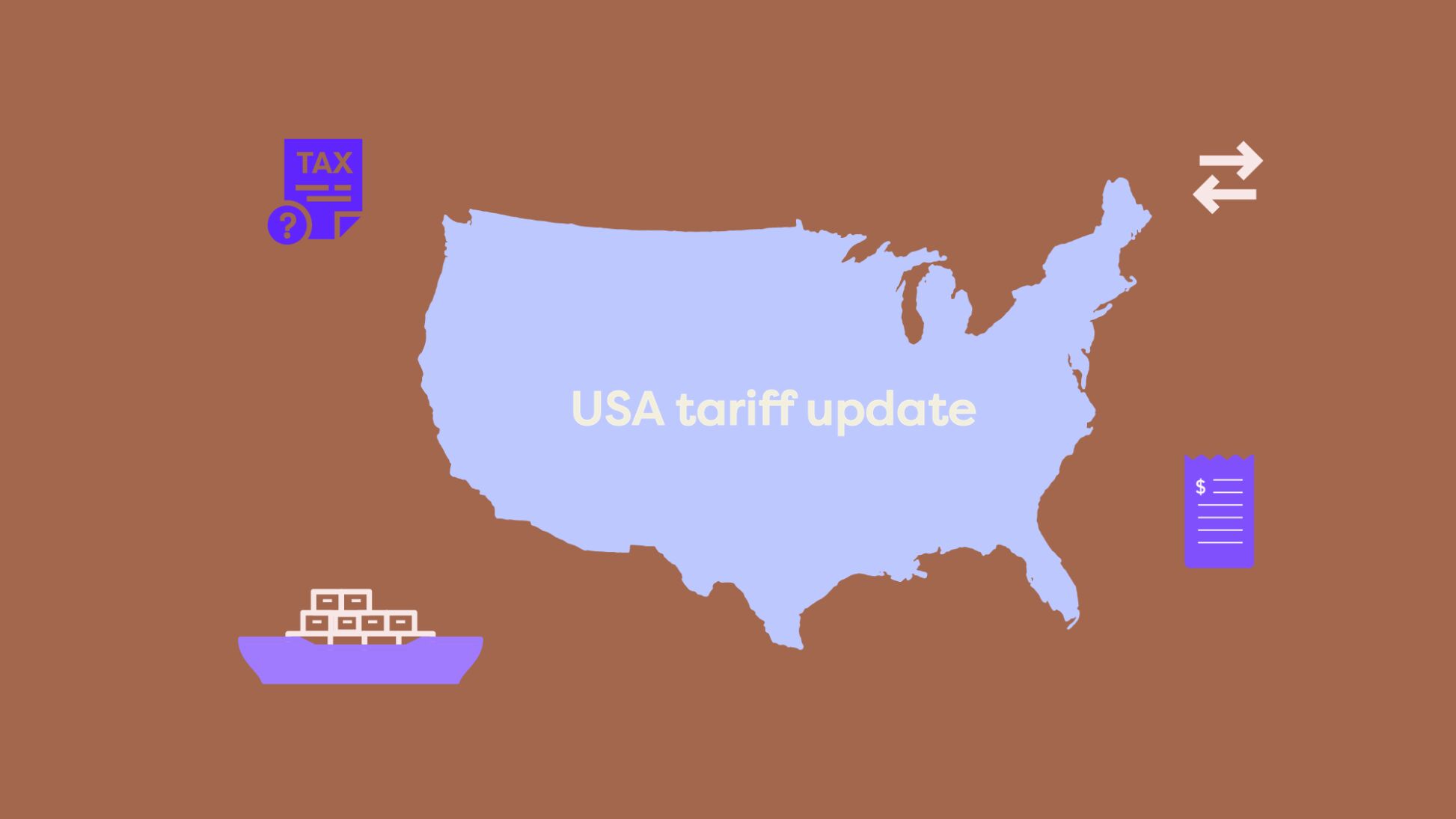In the wake of newly imposed tariffs and the removal of the de minimis threshold for all products shipped to the US, many retailers are wondering how it will affect their delivery processes, shipping costs and supply chains. We'll keep you up to date with the ever-evolving developments here.
Global trade tariff and duty situation explained. We bring you the latest news.
#Update – 19th August 2025
Reminder: De Minimis Rule Ending Soon
Here’s what you need to know to stay ahead of upcoming changes to U.S. import rules — and how SAMOS makes compliance simple.
Remember, changes to the U.S. de minimis duty-free exemption will take effect on 29th August 2025. This means all imports — including those under $800 — will now be subject to duties, regardless of origin or value.
While this may sound daunting, don’t worry — SAMOS has you covered. Staying compliant is easier than you think.
#What’s Changing?
For each commercial shipment, you’ll need to account for:
-The standard duty rate, based on your product’s HS code. Search here.
- The new adjusted tariff rate for UK exports, currently 10%. Check here and scroll to the bottom for the tariff assigned to the country of orignn of your product.
Looking for examples? Check out our blog post here for real-world scenarios using common product categories, or see below from our 13th August update.
Note: SAMOS will continue to pay duties and tariffs on your behalf, then invoice them back to you. Be aware, anything shipped after 22nd August will most likely have duties applied and tariffs charged on import to the U.S.
#What’s NOT Changing?
- You can still ship to the U.S. with no issues
- Your goods will still arrive on time
- Our service remains just as reliable
- Your customers won’t face surprise fees on delivery
Need Help?
We’re here to support you. If you have any questions about the changes or how to ensure smooth, compliant shipping to the U.S., contact us here — we’re happy to help. Our service to the US has no minimum duty fee, we don't surcharge for volumetric packages and delivery is 3 to 4 days. View the fixed pricing with no surcharges here .
Update – 13 August 2025
How to Prepare for the End of the U.S. De Minimis Rule
We bring you the latest news on the U.S. trade tariffs, including the changes to the long-standing de minimis exemption and how to calculate the costs.
Big changes are coming on 29 August 2025. The U.S. is eliminating the de minimis duty-free exemption, meaning all imports — including those under $800 — will now be subject to duties, regardless of origin or value.
#What You Need to Know
• Every shipment will incur duties • Country of origin must be declared • Changes take effect 12:01 a.m. EDT, 29 August 2025
#Calculating the Financial Impact
To estimate how much more you'll pay:
- Find the HS code and duty rate of your product here: US Harmonized Tariff Schedule
- Apply the new UK reciprocal tariff (currently 10%): See White House announcement here
Example 1: Umbrella ($15)
- HS code 6601: 0% duty = $0.00
- UK tariff: 10% = $1.50
- $1.50 + $0.00
- Total = $1.50
Example 2: Women’s cotton dress ($40)
- HS code 6204.12.00: 14.9% duty = $5.96
- UK tariff: 10% = $4.00
- $5.96 + $4.00
- Total = $9.96
#Top Tip
Review your product classifications and factor in both duty rates and tariffs ahead of time to avoid surprises once the new rules hit.
#Questions or Concerns?
SAMOS closely monitors market developments so that we can take care of the complexities of international shipping and help you stay one step ahead of global changes. For more insights and support get in touch.
#Update – 7th August 2025
De Minimis Era Ends August 29th 2025
As of August 29th 2025, the U.S. will end its long-standing $800 de minimis exemption for global shipments — meaning all US imports will now be treated as dutiable, regardless of their value or origin.
What’s changing?
On July 30, the Trump Administration announced it would suspend the global de minimis threshold for commercial imports for all countries. This executive order ends the duty-free rule for shipments valued under $800, which previously entered the U.S. without customs duties.
From 12:01 a.m. EDT on August 29, 2025, all goods imported for consumption will be subject to duty tax — no exceptions.
#What does the suspension of US de minimis and duty changes mean for e-commerce business?
- Duties will apply to every shipment, regardless of value or size
- For shipments sent by postal services only, a minimum temporary flat-rate duty option from $80 per shipment will be charged for six months. Contact us if you think the minimum duty of $80 will apply to the postal service you currently use to the US.
- All shipments must include country of origin information.
How can SAMOS help?
This ruling marks a major shift in international retail logistics. But it doesn’t have to disrupt the way you ship your parcels. SAMOS was built for flexibility — and we’re ready to help you navigate the changes with smart, strategic solutions.
We’re closely monitoring market developments and working to secure the most competitive rates for our clients. More specifics to be added shortly – please visit this page again in a few days.
Questions or concerns?
Get in touch — our team is here to help you adapt and stay ahead.
#May 2025 update
-
Following ongoing hikes in trade tariffs between the US and China, the US slashed tariffs on Chinese goods on 13th May from 145% to 30% – initially for a 90-day period.
-
In return, China cut its own tariffs on US imports from 125% to 10%.
-
In the wake of these changes, President Trump has further stipulated reduced tariffs on small packages worth up to $800 (£606) from 120% to 54%, according to a White House statement.
-
The US agreed to reduce import taxes on a set number of British cars and allow some steel and aluminium into the country tariff-free, as part of a new deal between the US and UK. Import tax on cars (which the US raised to 25% last month), has been reduced to 10% for 100,000 cars a year.
#April 2025 update
The US made two critical policy changes.
-
Additional tariffs of at least 10% to be added to all global imports. This was implemented as of 12.01 a.m. on 5 April 2025 EDT.
-
The end of the duty-free de minimis exemption for goods originating from the People’s Republic of China (PRC) and Hong Kong. This was implemented as of 12.01 a.m. on 2 April 2025 EDT and is subject to the Customs Border Patrol (CBP) having adequate measures in place to collect funds. As of 2 May 2025, anything imported to the U.S. with country of origin as China or Hong Kong are exempt from the de minimis threshold.
-
From 3 April, a 25% tariff on all passenger vehicles and light trucks. Tariffs of 25% on automobile parts are due to be implemented no later than 3 May.
#February 2025 Update
On Sunday 2nd February, the US announced the proposed implementation of tariffs on goods entering the USA from Canada, China and Mexico. They have decided to defer these plans for 30 days in the case of Canada and Mexico.
Additionally, the US plans to extend the de minimis exemptions for goods originating from the same three countries. This means that low value parcels under the value of $800 will no longer enter the US duty free.
Added to this, the US announced a new measure this week of reciprocal tariffs for individual countries based on trading agreements, including imports and exports. Value-added taxes – taxes levied to goods during each stage of production – will be considered as tariffs as part of the reciprocal plan.
A fact sheet published by the US government can be viewed here.
#What are tariffs and why are they imposed?
Put simply, tariffs are the taxes on goods imported from other countries. They aim to protect domestic manufacturers by making locally made goods cheaper.
#How much are the proposed US tariffs?
25% tariff on goods with a country of origin of Mexico – delayed for 30 days 25% tariff on goods with a country of origin of Canada (10% for energy products) – delayed for 30 days An additional 10% tariff on goods with a country of origin of China
Reciprocal tariffs worldwide to be calculated on individual countries trading agreements
#We’re ready to support you through this ever-changing landscape
At SAMOS, we specialise in helping e-commerce companies navigate the complexities of international trade and shipping. Our in-house experts are closely monitoring the situation as it unfolds so that we can ensure our customers’ deliveries are fully compliant and all duties are appropriately charged.
Our in-depth expertise of cross-border logistics and global customs enable us to tailor solutions to e-commerce companies. We aim to always keep shipping simple, streamlined and cost effective.
If you’re concerned about these regulatory changes, get in touch, and we’ll help you decipher the information and adapt to the challenges ahead.


